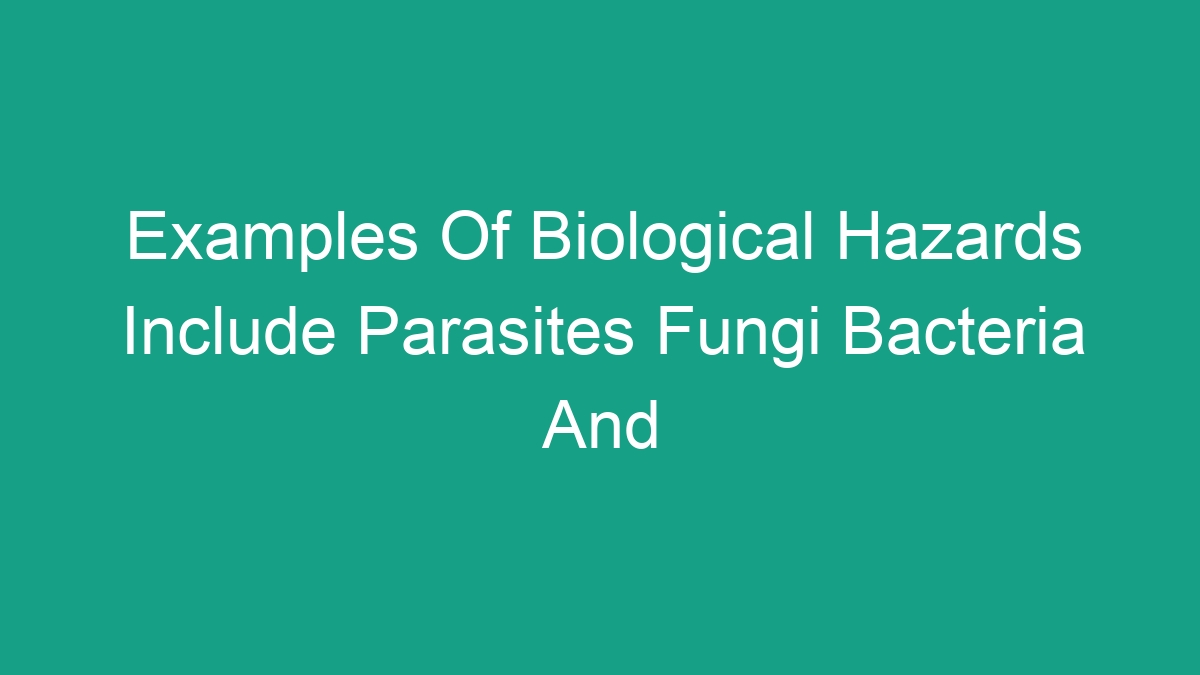
Biological hazards are organisms, or substances produced by organisms, that pose a threat to human health. They can be found in a variety of settings, including workplaces, homes, and outdoor environments. Examples of biological hazards include parasites, fungi, bacteria, and viruses, among others. In this article, we will focus on the examples of parasites, fungi, and bacteria, and the potential health risks they pose to humans.
Examples of Biological Hazards
Parasites: Parasites are organisms that live on or inside another organism, called a host, and benefit at the host’s expense. There are various types of parasites that can pose a biological hazard to humans. Some common examples include:
1. Protozoa: Protozoa are single-celled organisms that can cause diseases such as malaria, giardiasis, and toxoplasmosis. These microorganisms can be transmitted through contaminated food and water, and can cause severe health complications if not treated promptly.
2. Helminths: Helminths are parasitic worms that can infect the intestines, lungs, liver, and other organs. Some well-known helminths include tapeworms, roundworms, and flukes. Infections with helminths can lead to malnutrition, anemia, and organ damage.
3. Arthropods: Arthropods such as ticks, mites, and lice can also act as biological hazards by transmitting diseases to humans. Lyme disease, Rocky Mountain spotted fever, and typhus are examples of illnesses caused by arthropod-borne parasites.
Fungi: Fungi are a diverse group of organisms that can be found in soil, water, air, and on plants and animals. While most fungi are harmless, some can pose a biological hazard to humans. Examples of pathogenic fungi include:
1. Aspergillus: Aspergillus is a common mold that can cause allergic reactions and respiratory infections in humans. Invasive aspergillosis can occur in people with weakened immune systems, leading to severe lung infections and other complications.
2. Candida: Candida is a type of yeast that can cause infections in the mouth, throat, and genital areas. Invasive candidiasis can occur in hospitalized patients, especially those in intensive care units and those receiving immunosuppressive treatments.
3. Coccidioides: Coccidioides is a fungus found in the soil of certain arid regions, and can cause a respiratory infection known as coccidioidomycosis, or Valley fever. This condition can range from mild flu-like symptoms to severe pneumonia and can affect both humans and animals.
Bacteria: Bacteria are single-celled microorganisms that can be found in various environments and can have both beneficial and harmful effects on humans. Some examples of pathogenic bacteria that pose biological hazards include:
1. Salmonella: Salmonella is a type of bacteria commonly found in animal feces, raw meat, and poultry. Ingesting contaminated food or water can lead to salmonellosis, causing diarrhea, fever, and abdominal cramps.
2. Escherichia coli (E. coli): While most strains of E. coli are harmless, certain pathogenic strains can cause severe illness, such as diarrhea, urinary tract infections, and even kidney failure. Contaminated food, water, and contact with infected animals can transmit the bacteria to humans.
3. Lyme Disease Bacteria: The bacterium Borrelia burgdorferi is transmitted to humans through the bite of infected blacklegged ticks. Lyme disease can cause a range of symptoms, including fever, headache, and a characteristic skin rash, and can lead to severe complications if left untreated.
Health Risks and Preventive Measures
Parasites: Infections with parasites can lead to a range of health issues, including gastrointestinal problems, anemia, and organ damage. To prevent parasitic infections, individuals should practice good hygiene, such as washing hands regularly, drinking clean water, and cooking food thoroughly. In addition, avoiding contact with potentially contaminated soil and water can reduce the risk of parasitic infections.
Fungi: Fungal infections can cause respiratory problems, skin irritations, and systemic illnesses in humans. To minimize the risk of fungal hazards, it’s important to maintain clean indoor environments, address moisture and ventilation issues, and avoid activities that can lead to exposure to environmental molds and fungi. In healthcare settings, strict infection control measures are crucial for preventing the spread of pathogenic fungi.
Bacteria: Bacterial infections can range from mild to life-threatening, depending on the type of pathogen and the individual’s immune status. Proper food handling and preparation, along with regular handwashing, can reduce the risk of bacterial contamination and foodborne illnesses. Vaccination, proper wound care, and antimicrobial stewardship are also essential for preventing bacterial infections and reducing the spread of antibiotic-resistant bacteria.
Conclusion
Biological hazards, including parasites, fungi, and bacteria, can pose significant threats to human health. Understanding the examples of these hazards and the associated health risks is crucial for implementing preventive measures and minimizing exposure to these organisms. By practicing good hygiene, maintaining clean environments, and following proper food safety practices, individuals can reduce their risk of biological hazards and protect their health. Additionally, healthcare professionals and public health authorities play a critical role in surveillance, outbreak control, and education to mitigate the impact of biological hazards on human populations.



